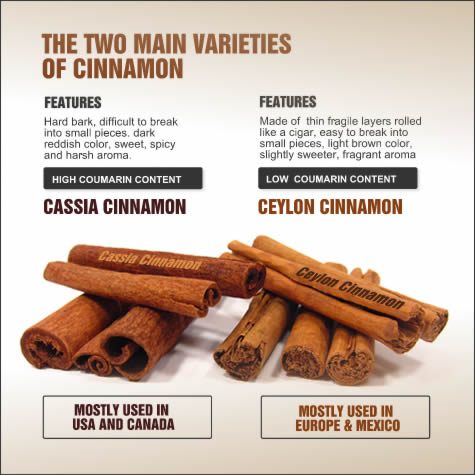Here is what you might not KNOW!
Used by ancient Egyptians and even referenced in the Bible, cinnamon has been known for its unique biological properties and health effects for thousands of years.
Today, science is proving the long-known cinnamon health benefits - from tackling blood sugar and diabetes to helping fight nasty infections, and even cancer.
However, it may surprise you that not all cinnamon is equal in quality - or safety.
Shockingly, the most widely used type of cinnamon in the world - the Cassia cinnamon, may even have the potential to damage your health.
Types of Cinnamon

There are two commonly available kinds of cinnamon:
- Cassia Cinnamon, made from the Chinese Cinnamon tree, Cinnamomum cassia.
- Ceylon Cinnamon, made from “True cinnamon” tree, Cinnamomum verum.
Several other kinds of cinnamon are not as popular or as readily available on the global market.
Cassia is the most common cinnamon in the global food industry. When the label reads “Cinnamon” only - the kind in question is cassia cinnamon.
Cinnamon Benefits
All cinnamon types have antimicrobial, antioxidant, anti‐inflammatory, anti‐fungal, anti-viral, anti-diabetic, anti‐cancer, and pro‐wound healing properties, and can help in fighting certain diseases. Determining the potency of each type of cinnamon for treating different alignments is still to be determined.

What is the difference between Cassia cinnamon and Ceylon cinnamon?
Although cassia cinnamon has undoubted benefits, it comes with one major drawback - the amount of coumarin.
Why is coumarin bad for you
Coumarin, an aromatic organic compound that is sometimes used as an anticoagulant drug, can have adverse health effects. Liver toxicity has been proven in both animal and human studies, and the research on cancers in humans is still ongoing.
While small amounts of coumarin won’t harm you, concentrations that exceed the recommended daily doses may lead to liver disease, and even an increased risk of certain types of cancers such as kidney adenomas, as animal studies show.

Also, research has shown that liver-toxic coumarin effects are more potent in an especially sensitive population. In certain individuals, the compound is quicker to damage the liver. To make things trickier, it seems impossible to know upfront who has a heightened sensitivity to coumarin.
Of course, a sprinkle Cassia here or there won’t harm you; however, it is very easy to find yourself in the coumarin danger zone if you use cinnamon regularly or abundantly. Just one or two teaspoons could take you beyond the safe daily dose of coumarin.
Ceylon Cinnamon Safety
Fortunately, it is easy to stay on the safe side. Ceylon cinnamon has up to 250 times less coumarin than Cassia (63 times on average). The content is so low (<=0.004%) that coumarin is often undetectable in Ceylon cinnamon - unlike with Cassia, which always contains roughly 1 percent of coumarin.
Conveniently, Ceylon cinnamon benefits remain the same or very similar to Cassia cinnamon benefits, and it is praised for its culinary properties and delicate taste.

You may wonder why Cassia cinnamon is still the most dominant type in the food industry despite its potentially dangerous health effects.
The answer is simple - Cassia cinnamon is produced in greater quantities. Therefore, it is available and cheap, making it the most profitable option for an average producer.
Mujeza-al Shifa’s policy is to choose only the highest-quality ingredients for its products. For our Black Seed Honey with Cinnamon and Turmeric, we have opted for Ceylon cinnamon. That way, we ensure you can fully enjoy the rich cinnamon aroma and all the healing properties without endangering your health.
SHOP NOW
References
Ahmed, J., Altun, E., Aydogdu, M. O., Gunduz, O., Kerai, L., Ren, G., & Edirisinghe, M. (2019, February 15). Anti‐fungal bandages containing cinnamon extract. Retrieved from https://onlinelibrary.wiley.com/doi/full/10.1111/iwj.13090#iwj13090-bib-0001
Ceylon cinnamon: Health benefits, uses, and more. (n.d.). Retrieved from https://www.medicalnewstoday.com/articles/318386
Ceylon vs. Cassia — Not All Cinnamon Is Created Equal. Retrieved from
https://www.healthline.com/nutrition/ceylon-vs-cassia-cinnamon#
Levels of coumarin in cassia cinnamon vary greatly even in bark from the same tree. (n.d.). Retrieved from: https://www.acs.org/content/acs/en/pressroom/presspacs/2010/acs-presspac-november-3-2010/
levels-of-coumarin-in-cassia-cinnamon-vary-greatly-even-in-bark-from-the-same-tree.html
Kazeem, T. D., WL. Baker, G. G., Medagama, A., RB. Costello, J. D., X. Peng, J. M., Yasmin. Bains, A. G., . . . M. Hellwig, T. H. (1970, January 01). Cinnamon Shows Antidiabetic Properties that Are Species-Specific: Effects on Enzyme Activity Inhibition and Starch Digestion. Retrieved from https://link.springer.com/article/10.1007/s11130-019-00760-8
Raman, R. (2005, September 05). 6 Side Effects of Too Much Cinnamon. Retrieved from https://www.healthline.com/nutrition/side-effects-of-cinnamon#1
Singh, J., Singh, R., Parasuraman, S., & Kathiresan, S. (n.d.). Antimicrobial Activity of Extracts of Bark of Cinnamomum cassia and Cinnamomum zeylanicum. Retrieved from http://jpionline.phcog.interactivedns.com/index.php/ijpi/article/view/683
Steffensen, I., Alexander, J., Binderup, M., Dahl, K. H., Granum, B., Hetland, R. B., . . . Thrane, V. (n.d.). Risk Assessment of Coumarin Intake in the Norwegian Population. Retrieved from https://www.journalejnfs.com/index.php/EJNFS/article/view/30143



